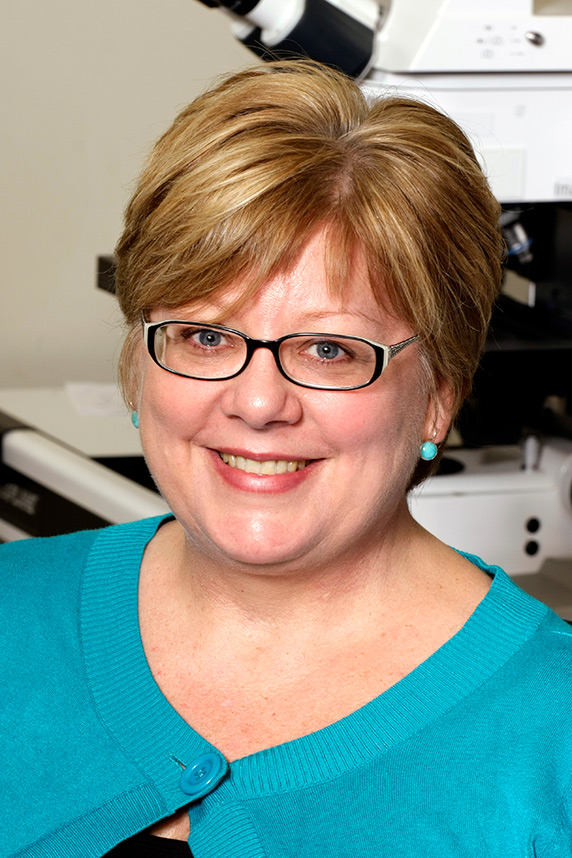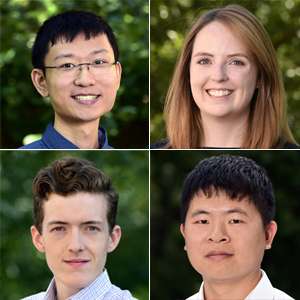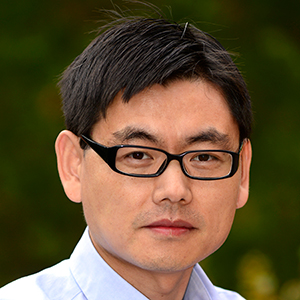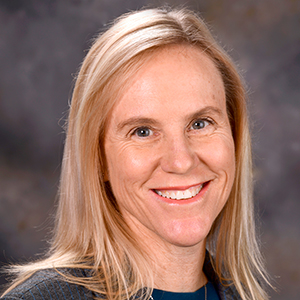 Researchers use Jensen’s mouse lines to study infectious disease, the heart, stem cells, immunology, and more. “Any question that is related to diversity within a larger population [of cells],” Jensen said. (Photo courtesy of Steve McCaw)
Researchers use Jensen’s mouse lines to study infectious disease, the heart, stem cells, immunology, and more. “Any question that is related to diversity within a larger population [of cells],” Jensen said. (Photo courtesy of Steve McCaw)NIEHS gained another tenured researcher with the announcement Aug. 5 that neurobiologist Patricia Jensen, Ph.D., received a unanimous vote by the National Institutes of Health (NIH) Central Tenure Committee. At NIEHS, Jensen combines scientific excellence with a strong mentoring program.
As head of the NIEHS Developmental Neurobiology Group, Jensen has developed new tools to study a small population of neurons in the brain that produce the neurotransmitter norepinephrine. Called noradrenergic neurons, these cells are involved in a wide range of critical behaviors and physiological processes.
“Noradrenergic neurons are difficult to study because they are scattered deep in the brain stem and few in number,” Jensen said. “And there was no genetic marker to use, either. So, I made the tools that allow me to study them.”
That can-do attitude is part of what makes Jensen a successful scientist. “She does paradigm-shifting work and is literally rewriting text books on the noradrenergic system,” said Neurobiology Laboratory Chief Jerry Yakel, Ph.D.
Mentor to prizewinners
Her strengths go well beyond the lab bench, according to Yakel. “She is one of the best mentors at NIEHS,” Yakel continued. “She’s also very committed to diversity. Not only her postdocs, but her postbac [postbaccalaureate] and summer students do great work and win a lot of awards while being trained in her lab.” Three trainees received awards in August.
 When Yakel took the reins of the Neurobiology Laboratory in 2013, Jensen was already on board. “She is simply outstanding,” he said. (Photo courtesy of Steve McCaw)
When Yakel took the reins of the Neurobiology Laboratory in 2013, Jensen was already on board. “She is simply outstanding,” he said. (Photo courtesy of Steve McCaw)- NIEHS Scholars Connect Program student Naudia Gay won Best Poster Award (see related story).
- Postdoctoral Intramural Research Training Award (IRTA) fellow Irina Evsyukova, Ph.D., won a NIH FARE award.
- Senior postdoctoral IRTA fellow Natale Sciolino, Ph.D., was awarded an NIH Pathway to Independence Award from the National Institute of Diabetes and Digestive and Kidney Diseases.
Evidence of Jensen’s pride in her students and devotion to their success extends to her curriculum vitae, which lists her former summer interns and trainees and where they are now — professors, medical residents, graduate and undergraduate schools, and more.
For Jensen, the path to tenured researcher is one she never imagined for herself. She was the first in her family to go to college and did not have mentors. “We didn’t know about this world,” she said.
Her love of science led her to volunteer in labs — on top of school and full-time work. “I did it not for a career, but because it was fun,” she said. Then came the day a neuroscientist in a lab she was working in told her, “You need to apply to graduate school.”
Redefining neuron characteristics
Today, Jensen is the author of groundbreaking studies showing that noradrenergic neurons are not homogenous, as previously thought. In a paper published in 2013, she classified noradrenergic neurons based on differences in their gene expression. The advance is significant enough to be included on the NIH Accomplishments site.
“Conducting groundbreaking research isn’t always easy,” Jensen said. During her first lab review, one scientist on the panel insisted that noradrenergic neurons were all homogeneous. Her papers later proved that reviewer wrong.
Or take another recent finding, which demonstrated that one neuron subpopulation promotes a better coping response to stress and decreases anxiety-like behavior when activated in mice. This result contrasts with the general belief that noradrenergic signaling promotes the stress response.
Now, variation among noradrenergic neurons is an accepted fact of neurobiology. In August, Jensen and Sciolino returned from a Gordon Conference on the topic, where both were invited to speak.
“Other speakers at the conference were using the mouse models we developed,” Jensen noted. Her models allow genetic manipulation of noradrenergic subpopulations. They are helping to explain why studies have shown inconsistencies in neurons’ response to norepinephrine.
“You can’t look at these neurons as single population,” she said. “They don’t all do the same thing.”
Citations:
Robertson SD, Plummer NW, de Marchena J, Jensen P. 2013. Developmental origins of central norepinephrine neuron diversity. Nat Neurosci 16(8):1016–1023.
Sciolino NR, Plummer NW, Chen YW, Alexander GM, Robertson SD, Dudek SM, McElligott ZA, Jensen P. 2016. Recombinase-dependent mouse lines for chemogenetic activation of genetically defined cell types. Cell Rep 15(11):2563−2573.
Chen YW, Das M, Oyarzabal EA, Cheng Q, Plummer NW, Smith KG, Jones GK, Malawsky D, Yakel JL, Shih YI, Jensen P. 2018. Genetic identification of a population of noradrenergic neurons implicated in attenuation of stress-related responses. Mol Psychiatry 24(5):710–725.









